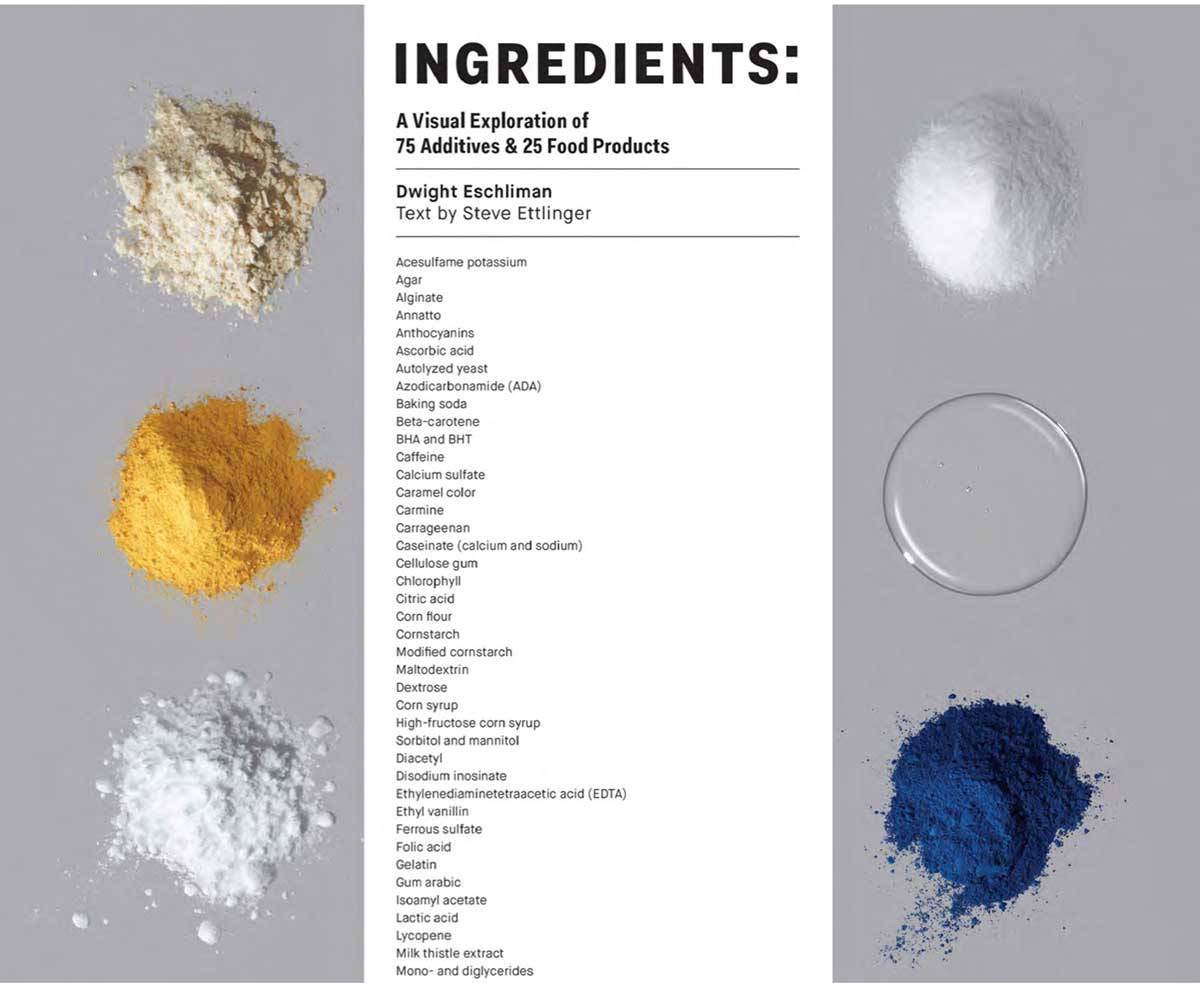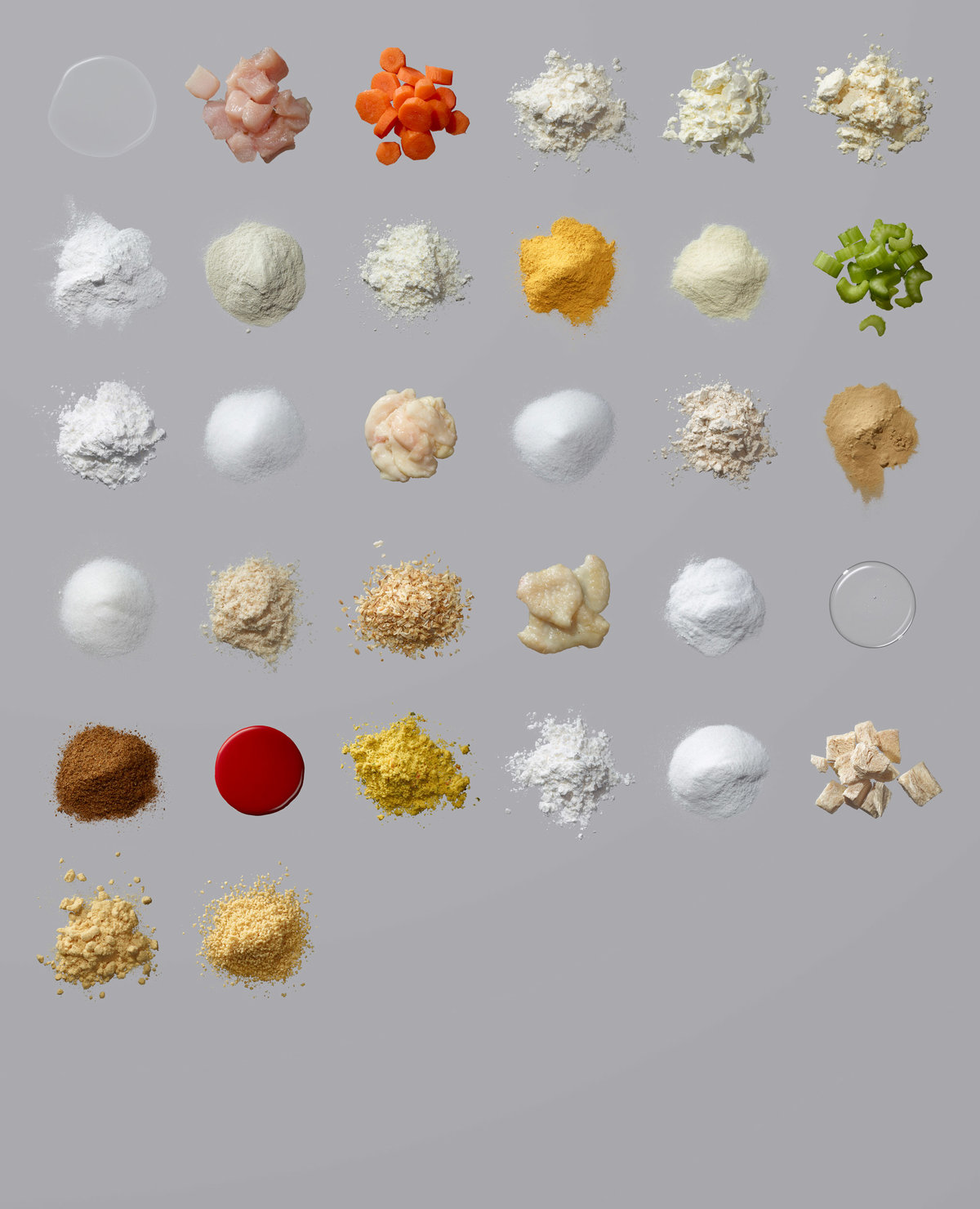New Book, “Ingredients,” Deconstructs Foods Through Photographs and Words
The new book, “Ingredients: A Visual Exploration of 75 Additives and 25 Food Products,” deconstructs the foods you find at your local grocery store.
New Book, “Ingredients,” Deconstructs Foods Through Photographs and Words
The new book, “Ingredients: A Visual Exploration of 75 Additives and 25 Food Products,” deconstructs the foods you find at your local grocery store.

The natural colorant, carmine, found in these products is made from the dried bodies and eggs of the female cochineal insect that live on the prickly pear cactus found in Mexico and South America. It takes about 70,000 of the insects to make a pound of carmine. Shellac (also bug-related; it’s made from insect larvae excretions), isn’t just the stuff you slathered on your woodworking project in grade school. It’s also a common food additive used on everything from vegetables to chocolate to coffee beans to chewing gum and often goes by the unassuming name “food glaze” in ingredients lists.
These are just a few of the fascinating – and sometimes disturbing facts – that accompany the stunning photos in Ingredients, a new book released yesterday by Regan Arts, which examines 75 additives (some natural, some not) that are in many of the foods you find on supermarket shelves. The book, by photographer Dwight Eschliman with text by author Steve Ettlinger, also visually dissects 25 well-known processed foods, including Ocean Spray fruit juice (12 ingredients), Red Bull (17 ingredients), and Morningstar Farms soy sausage (42 ingredients).

It was the most-American of processed foods, the Twinkie, that brought Eschliman and Ettlinger together for this book. Each had worked on projects related to the golden sponge cake with a cream center.
“Steve and I independently worked on taking a Twinkie apart in our own ways. He did a lot of research and wrote a very successful book Twinkie, Deconstructed, and I had been looking for iconic things to [visually] deconstruct and landed on the Hostess family,” Eschliman tells Modern Farmer by phone from his home outside San Francisco.
When Eschliman decided he wanted to do a book-length project about additives, he naturally turned to Ettlinger to write the text. Eschliman says that neither of them “are up on a soapbox saying the food industry is all bad” but “shared a fascination and mistrust of the food industry in general.”
For this project, Eschliman, 43, started with a list of several hundred food additives and, with Ettlinger’s help, narrowed them down to the 75 that ended up in the book. Eschliman describes them as a mix of what he considered “bad, neutral, or good,” but it also came down to ingredients with interesting backstories. Eschliman also admits that “it’s hard to resist an extremely long, complicated chemical name when you’re talking about additives.”
In the second part of the book, they narrowed down the processed foods to 25, which Eschliman says wasn’t easy.
“We hit the expected foods – Twinkies, Chicken McNuggets, the stuff that people talk about a lot – but still maintained a balance between what is perceived as junk food or bad food and good food – also some interesting stuff in between, like Red Bull,” he says.
There were a variety of complications that had to be worked through for both Eschliman and Ettlinger. For the photographer, it was a challenge to make “white powders and clear liquids interesting to look at” since that’s what many additives are. To achieve the beautiful results, they built small, narrow aquariums and then “did exhaustive testing on how to create the pours along the surface of the liquid to make it interesting.”


Another stumbling block: The inability to get their hands on high fructose corn syrup. Eschliman references a Huffington Post article that claimed it was easier to get a gun than the highly-concentrated sweetener.
“We even had two friends who have a legit food business request samples and they told them ‘no.’ The companies were suspicious that they weren’t legit even though they were,” he says. “You can’t buy the stuff, yet it’s in everything you eat. I suppose if you were willing to pony up for a train car of the stuff there would be less suspicion.” They ended up having to use a sample that was several years old.
For Ettlinger, 66, writing the text presented its own challenges. He says it isn’t easy “to explain common but complicated things with the right amount of detail to inform the consumer, while perhaps entertaining and intriguing them without pissing off the scientific community.”
The book, the authors say, isn’t meant to be political or an indictment of the food industry, but rather, it’s meant to inform consumers about their food choices.
“There are a lot of people on soapboxes and there are a lot of people defending the food industry, but there just wasn’t a lot of observational, in-between material,” says Eschliman. “It made the most sense to push it down the middle.”
Eschliman says growing up his mother was quite strict when it came to their diet so he never had junk food, but as an adult he probably consumes more bad stuff than he should. He admits that “every once in awhile” he enjoys “a little Taco Bell on a road trip” but that since working on Ingredients “there is some stuff included in the book that I’d rather not put in my body.”
For Ettlinger, working on the book hasn’t really changed his shopping habits, though he reads labels more thoroughly now. It has also reinforced his desire “to buy and eat whole foods, and local” when he can.
Follow us
This work is licensed under a Creative Commons Attribution-NoDerivatives 4.0 International License.
Want to republish a Modern Farmer story?
We are happy for Modern Farmer stories to be shared, and encourage you to republish our articles for your audience. When doing so, we ask that you follow these guidelines:
Please credit us and our writers
For the author byline, please use “Author Name, Modern Farmer.” At the top of our stories, if on the web, please include this text and link: “This story was originally published by Modern Farmer.”
Please make sure to include a link back to either our home page or the article URL.
At the bottom of the story, please include the following text:
“Modern Farmer is a nonprofit initiative dedicated to raising awareness and catalyzing action at the intersection of food, agriculture, and society. Read more at <link>Modern Farmer</link>.”
Use our widget
We’d like to be able to track our stories, so we ask that if you republish our content, you do so using our widget (located on the left hand side of the article). The HTML code has a built-in tracker that tells us the data and domain where the story was published, as well as view counts.
Check the image requirements
It’s your responsibility to confirm you're licensed to republish images in our articles. Some images, such as those from commercial providers, don't allow their images to be republished without permission or payment. Copyright terms are generally listed in the image caption and attribution. You are welcome to omit our images or substitute with your own. Charts and interactive graphics follow the same rules.
Don’t change too much. Or, ask us first.
Articles must be republished in their entirety. It’s okay to change references to time (“today” to “yesterday”) or location (“Iowa City, IA” to “here”). But please keep everything else the same.
If you feel strongly that a more material edit needs to be made, get in touch with us at [email protected]. We’re happy to discuss it with the original author, but we must have prior approval for changes before publication.
Special cases
Extracts. You may run the first few lines or paragraphs of the article and then say: “Read the full article at Modern Farmer” with a link back to the original article.
Quotes. You may quote authors provided you include a link back to the article URL.
Translations. These require writer approval. To inquire about translation of a Modern Farmer article, contact us at [email protected]
Signed consent / copyright release forms. These are not required, provided you are following these guidelines.
Print. Articles can be republished in print under these same rules, with the exception that you do not need to include the links.
Tag us
When sharing the story on social media, please tag us using the following: - Twitter (@ModFarm) - Facebook (@ModernFarmerMedia) - Instagram (@modfarm)
Use our content respectfully
Modern Farmer is a nonprofit and as such we share our content for free and in good faith in order to reach new audiences. Respectfully,
No selling ads against our stories. It’s okay to put our stories on pages with ads.
Don’t republish our material wholesale, or automatically; you need to select stories to be republished individually.
You have no rights to sell, license, syndicate, or otherwise represent yourself as the authorized owner of our material to any third parties. This means that you cannot actively publish or submit our work for syndication to third party platforms or apps like Apple News or Google News. We understand that publishers cannot fully control when certain third parties automatically summarize or crawl content from publishers’ own sites.
Keep in touch
We want to hear from you if you love Modern Farmer content, have a collaboration idea, or anything else to share. As a nonprofit outlet, we work in service of our community and are always open to comments, feedback, and ideas. Contact us at [email protected].by Andrew Amelinckx, Modern Farmer
September 30, 2015
Modern Farmer Weekly
Solutions Hub
Innovations, ideas and inspiration. Actionable solutions for a resilient food system.
ExploreExplore other topics
Share With Us
We want to hear from Modern Farmer readers who have thoughtful commentary, actionable solutions, or helpful ideas to share.
SubmitNecessary cookies are absolutely essential for the website to function properly. This category only includes cookies that ensures basic functionalities and security features of the website. These cookies do not store any personal information.
Any cookies that may not be particularly necessary for the website to function and are used specifically to collect user personal data via analytics, ads, other embedded contents are termed as non-necessary cookies.